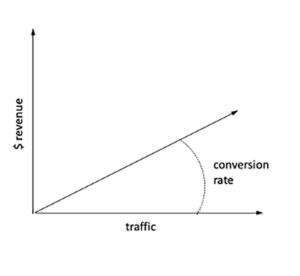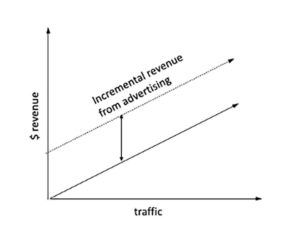By Jason Pratt, General Manager, Koddi Ads
Companies who operate digital marketplaces (“operators”) generally strive to maximize a variety of performance metrics related to user experience, acquisition cost, and revenue per session or user, all while innovating and expanding the size and scope of their marketplace property.
When considering the ways marketplaces can generate revenue, there are three basic options available to operators: subscription fees for membership (for buyers or sellers, or both), transaction fees (charged to buyers or sellers, or both), or advertising/media fees.
Considering the first two types of fees, whether they’re charged on a subscription or at the time of the transaction, they both affect the ratio between a marketplace’s overall traffic and the revenue it generates, like so:
 The more conversions (either to subscribers or transactions) that occur, the more revenue the marketplace generates. The higher the rate of conversion, the more revenue the marketplace generates at any given traffic level.
The more conversions (either to subscribers or transactions) that occur, the more revenue the marketplace generates. The higher the rate of conversion, the more revenue the marketplace generates at any given traffic level.
To boost marketplace revenues with these types of fees, operators must either (a) increase traffic (i.e., move to the right on the graph) or (b) increase conversion rate (i.e., increase the slope of the revenue line).
There is a third way to higher revenue, which is to increase fees, but this is both difficult to do and isn’t much different mathematically from increasing the conversion rate; both increase revenue per user, changing the slope of the line that represents revenue generated.
Increasing traffic is done by marketing and advertising the marketplace itself and its benefits, which is an expensive and slow proposition. If the marketplace doesn’t generate at least enough revenue to pay for the cost of bringing people to it, it will not last long. In reality, it needs to generate a lot more — to fund innovation, support personnel, etc. — so the conversion rate of the marketplace is critical to its survival and growth. Anything that can help increase the conversion rate will help the growth of the marketplace. In a fees-based marketplace, this means generating more subscribers, or more transactions.
Boosting the conversion rate is also difficult and expensive. Somehow, the operator must find ways to make the marketplace offering more attractive to more consumers. A/B testing, messaging changes, trial and error, lowering transaction flow barriers, and so forth are constantly and consistently pursued by the design & technology teams involved in marketplaces. Many of these experiments work to raise the conversion rate by some amount, but most fail and either have no impact or actually lower the conversion rate (and hence are reversed.)
So here we see the economic challenge of operating a successful, growing marketplace. It can be summed as follows:
“A marketplace must generate sufficient revenue from its activities to sustain itself and its growth, but the methods of generating and increasing revenue are exceptionally difficult and expensive to achieve.”
Introducing Advertising to the Equation
People come to marketplaces to buy. But they also come to marketplaces to see what is available to be bought; in other words, to shop.
Marketplaces typically overlook the value of shopping that they provide and focus entirely on the transactions they generate. Perhaps this is because most marketplaces generate fees for transactions, not shopping. Shopping is free in almost all marketplaces.
Here’s the truth though consumers value and choose marketplaces in the first place because they allow for the easy comparison between competing products or services — that is, they allow comparison shopping. The buyer’s alternative, shopping directly with each seller, is much more time-consuming and difficult than simply hitting a marketplace to see everything that is available.
As it turns out, sellers desperately want to stand out when buyers are comparison shopping. Just like marketplaces have marketing budgets that they use to bring people to the marketplace, sellers in marketplaces have marketing budgets that they want to spend to influence consumers to buy their products.
Most marketplaces do not know how to tap into those budgets to generate revenue for themselves or assume that sellers don’t want to spend those marketing budgets in their marketplace.
In reality, sellers are able and willing to spend marketing dollars in marketplaces. The buyers in a marketplace are bottom-funnel; they’re in buying mode. This means they’re among the best uses of a seller’s marketing budgets if those sellers are interested in selling their offerings.
Additionally, advertising revenues do not depend on transactions, subscriptions, or any other event besides traffic. In this way, they offer a second monetization lever to the operator. By introducing another lever, advertising helps operators maximize their revenue-per-user and makes them less reliant on pure conversion rate. Advertising revenue boosts (sits atop) translation revenue:
 Notice that in the illustration, the (dotted) line representing advertising revenue simply shifts upward the marketplace revenue (solid) line. If the conversion rate increases (and the line gets steeper), then that benefit is reflected in the advertising revenue, also – automatically and mathematically.
Notice that in the illustration, the (dotted) line representing advertising revenue simply shifts upward the marketplace revenue (solid) line. If the conversion rate increases (and the line gets steeper), then that benefit is reflected in the advertising revenue, also – automatically and mathematically.
Since we saw that any revenue to the marketplace increases its ability to grow, thrive, and market itself, it follows that advertising revenue can and should be pursued by every single operator that wants to grow their marketplace.
But let’s stop here with some caution: advertising does have the potential to detract from the user experience, and thus the conversion rate of the marketplace. We’ve all seen marketplaces full of ad banners, which we either navigate through or away from. It’s critically important that operators are careful about how they implement advertising so that they don’t distract from the core conversion rate of the marketplace.
Doing Advertising Correctly in a Marketplace
There are a few fundamental principles you must follow to do advertising right in a marketplace. These principles have been discovered in over 20 years of digital marketing practice:
- Ads must be relevant to their recipients.
- Ads must not distract from the buying flow, and ideally, they enhance or shorten the buying flow. (This can be measured by monitoring the marketplace conversion rate with and without ads.)
- There must be a balance between the number of ads and the number of organic results.
- Ads must be clearly disclosed as being ads.
- Users must know why they are seeing any given ad, and their data and personal privacy must be upheld.
We’ve found that the sponsored listing type of ad is a powerful, relevant, profitable, and positive addition to practically any marketplace. A sponsored listing is merely an organic listing boosted somehow into a more prominent position.
Sellers like sponsored listings because they take something already approved on the marketplace (the seller’s organic listing) and ‘boost’ it in front of more buyers, with no additional effort or creativity required.
Buyers like sponsored listings because they are relevant, look native, don’t distract or overpromise, and help get them to the purchase (which is what a buyer is on the marketplace to do, after all.)
Operators like sponsored listings because they are low-impact to implement, are highly profitable, perform well, and generate new revenue optimization levers that operators can employ to monetize their traffic most efficiently.
So, marketplace operators must consider all options when looking to grow their revenues, and thereby their marketplace. It’s important to understand the impact and challenges of each potential avenue. Subscription and transaction fees can be costly and intrusive to the overall experience. Advertising offers a powerful option to any marketplace operator, one that can easily be made to be additive to the overall user experience, while still yielding strong revenue growth.

